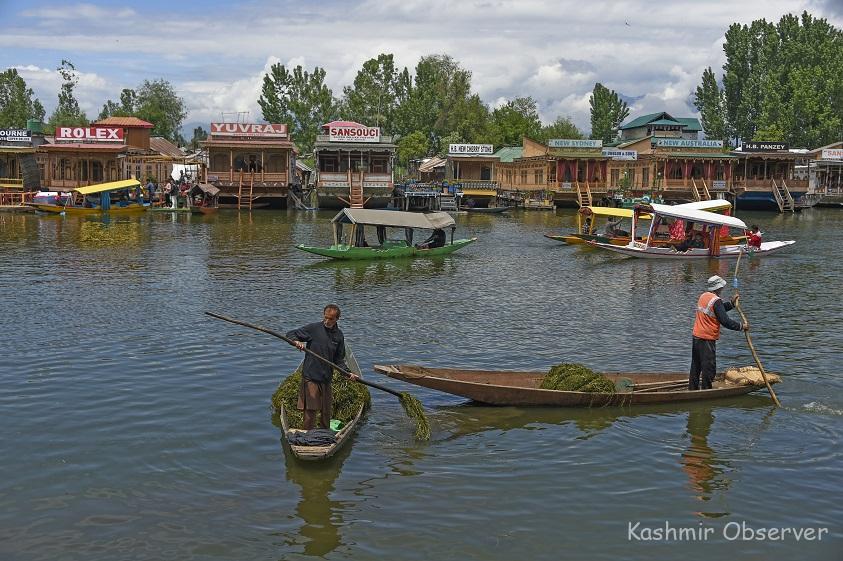
Srinagar- A recent study conducted by a team of scholars has unveiled that the water quality of the iconic Dal Lake and other lakes of Kashmir is steadily declining due to the presence of significant pollutants, rendering it unsuitable for both human consumption and the preservation of the local flora and fauna.
The study titled as “Molecular characterization of resistance determinants and mobile genetic elements of ESBL producing multidrug-resistant bacteria from freshwater lakes in Kashmir, India” which was conducted by New Delhi based scholar Insha Sultan and her colleagues confirmed the occurrence and dispersal of antibiotic- resistant bacteria in the freshwater system of Kashmir valley including the Dal Lake.
ESBL stands for Extended Spectrum Beta-Lactamase. Beta-lactamases are enzymes produced by some bacteria that may make them resistant to some antibiotics.
“We noticed the prevalence and co-occurrence of pollutants which includes ARGs, HMRGs, and MGEs in bacteria such as E. coli, Aeromonas sp, and Pseudomonas sp,” the study said.
Heavy Metal Resistance Genes (HMRGs) are pollutants which degrade water quality and make it unfit for human usage/consumption and the flora and fauna that exists in these lakes are sometimes taken as food source as well which deteriorates human health and leads to many illnesses and infections.
Antibiotic Resistance Genes (ARGs) were considered to be restricted to hospital settings only but now we are seeing them in community settings such as water environment, soil etc which itself is alarming. As it is escalating antibiotic resistance more than ever.
The work in this paper is the first to outline the genetic environment of blaCTX-M-15 in E. coli and Aeromonas sp. from the aquatic environment in Kashmir.
“The presence of multidrug-resistant bacteria in the natural lake ecosystem is an alarming situation and detection of MGEs (Mobile genetic elements which help bacteria in the dissemination of resistance genes) holds importance as these elements act as vehicles for the speedy dissemination of resistance determinants among varied and geographically distinct bacterial species,” the research paper notes.
It further said that the presence of heavy metal resistance genes provides a clue that bacterial inhabitants had been under the selective pressure of heavy metals.
“Owing to the biodiversity significance of these lakes and no available baseline data this study emphasizes the active monitoring of resistance profiles and thorough genetic as well as molecular studies from such environments to contain the spread of resistance determinants and safeguard the natural lake ecosystems,” it added.
Notably, a major portion of the lake has been profoundly impacted by a red algae bloom, resulting in a noticeable alteration of the lake’s once-spectacular appearance. The area spanning from Nehru Park to the Mughal garden at Nishat has experienced a pronounced effect due to “eutrophication,” an aging process affecting aquatic ecosystems. The authorities are terming it “natural process”
An official from the Lake Conservation and Management Authority (J&K LCMA) told Kashmir Observer that the growth of human settlements in the lake’s catchment areas has imposed ecological stress, often manifesting as a decline in water quality.
However, LCMA’s consistent conservation efforts, he said, have significantly mitigated this deterioration.
“We have implemented several measures to preserve Dal lake, including deweeding, dredging, solid waste management, diversion of liquid waste to sewage treatment plants, catchment area restoration works, and the commissioning of settling basins,” he added.
The fresh study highlights the occurrence of ESBL producing bacteria in the aquatic environment of Kashmir that can serve as a reservoir of ARGs.
Follow this link to join our WhatsApp group: Join Now
Be Part of Quality Journalism |
Quality journalism takes a lot of time, money and hard work to produce and despite all the hardships we still do it. Our reporters and editors are working overtime in Kashmir and beyond to cover what you care about, break big stories, and expose injustices that can change lives. Today more people are reading Kashmir Observer than ever, but only a handful are paying while advertising revenues are falling fast. |
| ACT NOW |
| MONTHLY | Rs 100 | |
| YEARLY | Rs 1000 | |
| LIFETIME | Rs 10000 | |











